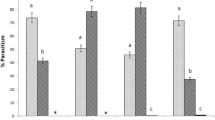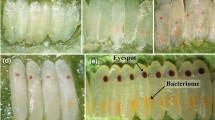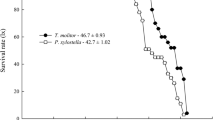Abstract
In the Republic of Benin, the African pink stem borer Sesamia calamistis Hampson is kept under control by the two scelionid egg parasitoids Telenomus busseolae (Gahan) and T. isis (Polaszek). A third species, the trichogrammatid Lathromeris ovicida Risbec, although commonly obtained from egg batches, is of low importance. High egg and egg batch parasitism by Telenomus spp. at low host densities suggests excellent host-finding capacity. Previously it was hypothesized that pheromones produced by calling S. calamistis virgins play an important role in attracting the parasitoids to the area where oviposition is likely to occur. Thus, after determining the effect of age (1–4 days) on the calling rhythm of S. calamistis, 1-day-old virgin females were chosen to investigate the response of the parasitoids to calling and noncalling females and two empty controls, in a four-arm olfactometer. The results showed that calling started earliest and lasted longest with 1-day-old females, but was similar for 2- to 4-days-old females. The percentage of females calling was higher in early than latter scotophases. The highest percentage of active females was obtained between 8 and 9 hr after the beginning of the first scotophase. All three parasitoid species responded to calling females, while there were no differences between noncalling females and the empty controls. The response pattern was similar for the two Telenomus spp. but considerably weaker for L. ovicida, reflecting differing host specificity of the three parasitoid species.
Similar content being viewed by others
References
Agboka, K., Schulthess, F, Chabi-Olaye, A., Gounou, A., and Smith, H. 2002. Self-, intra-and interspecific host discrimination in Telenomus busseolae Gahan and Telenomus isis Polaszek (Hymenoptera: Scelionidae) two sympatric egg parasitoids of the African cereal stem borer Sesamia calamistis Hampson (Lepidoptera: Noctuidae). J. Insect Behav. 15:1–17.
Babilis, N. A. and Mazomenos, B. E. 1992. Pheromone production in Sesamia nonagrioides: diel periodicity and effect of age and mating. J Insect Physiol. 38:561–564.
Baker, T. C. and Cardé, R. T. 1979. Endogenous and exogenous factors affecting periodicities of female calling and male sex pheromone response in Grapholitha molesta (Busck). J. Insect Physiol. 25:943–950.
Borgemeister, C., Schaefer, K., Goergen, G., Awandé, S., Sétamou, M., Poehling, H.-M., and Scholz, D. 1999. Host finding behavior of Dinoderus bifoveolatus (Coleoptera: Bostrichidae), an important pest of stored cassava: the role of plant volatiles and odors of conspecifics. Ann. Entomol. Soc. Am. 92:766–771.
Bosque-pérez, N. A. and Dabrowski, Z. T. 1989. Mass rearing of the maize stem borers: S. calamistis and E. saccharina at IITA. Toward Insect Resistant Maize for the Third World: Proceeding of the International Symposium on Methodologies for Developing Host Plant Resistance to Maize Insect. Centro International de Mejoramiento de Maez Trigo (CIMMYT), Mexico, D.F, Mexico, pp. 22–26.
Brady, U. E. and Smithwick, E. R. 1968. Production and release of sex attractant by female Indian meal moth Plodia interpunctella. Ann. Entomol. Soc. Am. 61:1260–1265.
Castrovillo, P. J. and Cardé, R. T. 1979. Environmental regulation of female calling and male pheromone response periodicities in the codling moth (Laspeyresia pomonella). J. Insect Physiol. 25:659–667.
Chabi-Olaye, A. 1992. Contribution à l'étude de la biologie et de l'écologie de Telenomus busseolae (Gahan) (Hyménoptère: Scélionidae) un parasitoide d'oeuf de Sesamia calamistis Hampson (Lépidoptère: Noctuidae). Thèse d'Ingénieur Agronome, Université Nationale du Bénin. pp. 70.
Chabi-Olaye, A., Schulthess, F., Shanower, T. G., and Bosque-pérez, N. A. 1997. Factors influencing the developmental rates and reproductive potentials of Telenomus busseolae Gahan (Hym.: Scelionidae), an egg parasitoid of Sesamia calamistis Hampson (Lep.: Noctuidae). Biol. Control 8:15–21.
Chabi-olaye, A., Schulthess, F., Poehling, H.-M., and Borgemeister, C. 2001. Host location and host discrimination behavior of Telenomus isis, an egg parasitoid of the African cereal stem borer Sesamia calamistis. J. Chem. Ecol. 27:663–678.
Coffelt J. A., Sower L. L., and Vick K. W. 1978. Quantitative analysis of identified compounds in pheromone gland rinses of Plodia interpunctella and Ephestia cautella at different times of day. Environ. Entomol. 8:587–590.
Colazza, S.; Rosi, M. C., and Clemente, A. 1997. Response of egg parasitoid Telenomus busseolae to sex pheromone of Sesamia nonagriodes. J. Chem. Ecol. 23:2437–2443.
Godfray, H. C. J. 1994. Parasitoids: Behavioral and Evolutionary Ecology. Princeton University Press, Princeton, New Jersey.
Jefferson, R. N., Shorey, H. H., and Gaston, L. K. 1966. Sex pheromones of noctuid moths. X. The morphology and history of female sex pheromone gland of Trichoplusia ni (Lepidoptera: Noctuidae). IBID 59:1166–1169.
Lewis, W. J., Nordlund, D. A., Guegner, R. C., Teal, P. E. A., and Tumlinson, J. H. 1982. Kairomones and their use for management of entomophagous insects. II. Mechanisms causing increase in rate of parasitization by Trichogramma spp. J. Chem. Ecol. 1:349–360.
Mayer, M. S. and Mankin, R. W. 1985. Neurobiology of pheromone perception. In. Kerkut, G. A., and L. I. Gilbert (Eds.), Comprehensive Insect Physiology Biochemistry and Pharmacology, Pergamon Press, Oxford, UK, pp 95–144.
Mazomenos, B. E. 1984. A sex attractant of the corn stalk borer Sesamia nonagrioides LEF.: Partial chemical purification and its biological activity under laboratory conditions. Med. Fac. Landbouww. Rijksuniv. Gent. 49:675–681.
Miller, J. R. and Roelofs, W. L. 1977. Sex pheromone titre correlated with pheromone gland developments and age in the redbanded leafroller moth, Argyrotaenia velutinanna. Ann. Entomol. Soc. Am. 70:136–139.
Mozuraitis, R., Buda, V., Jonusaite, V., Borg-Karlson, A.-K., and Noreika, R. 2000. Sex pheromones of Phyllonorycter acerifoliella and Ph. heegerella and communication peculiarities in three species of leafmining moths. Entomol. Exp. Appl. 94:15–23.
Nordlund, D. A. and Brady, U. E. 1974. Factors affecting release rate and production of sex pheromone by female Plodia interpunctella (Hübner) (Lep.: Pyralidae). Environ. Entomol. 3:797–802.
Polaszek, A. 1998. African cereal stem borers: economic importance, taxonomy, natural enemies and control. CAB International in association with the ACP-EU Technical Center for Agricultural and Rural Co-operation (CTA), 530pp.
Raina, A. K. and Klun, J. A. 1984. Brain factor control of sex pheromone in the female corn earworm moth. Science 225:531–533.
Raina A. K., Klun, J. A., and Stadelbacher, E. A. 1986. Diel periodicity and effect of calling age and mating on female sex pheromone titer in Heliothis zea (Lepidoptera: Noctuidae) Ann. Entomol. Soc. Am. 79:128–131.
SAS Institute. 1997. SAS/STAT Software: Changes and Enhancements, Through Release 6.12, SAS Institute Inc., Cary, North Carolina, 1167pp.
Scholz, D., Tchabi, A., Borgmeister, C., Markham, R. H., Poehling, H. M., and Lawson, A. 1997. Host-finding behaviour of Prostephanus truncatus: Primary attraction or random attack? J. Appl. Entomol. 121:216–269.
Schulthess, F., Bosque-Pérez, N. A., Chabi-Olaye, A., Gounou, S., Ndemah, R., and Goergen, G. 1997. Exchange of natural enemies of lepidopteran cereal stemborers between African regions. Insect Sci. Appl. 17:97–108.
Schulthess, F., Chabi-Olaye, A., and Georgen, G. 2001. Seasonal fluctuations of noctuid stem borer egg parasitism in southern Benin with special reference to Sesamia calamistis Hampson (Lep.: Noctuidae) and Telenomus spp. (Hym: Scelionidae) on maize. Biocontrol Sci. Technol. 11:745–757.
Sétamou, M. and Schulthess, F. 1995. The influence of eggs parasitoids belonging to the Telenomus busseolae (Hymenoptera: Scelionidae) species complex on Sesamia calamistis (Lepidoptera: Noctuidae) population in maize fields in Southern Benin. Biocontrol Sci. Technol. 5:69–81.
Shanower, T. G., Schulthess, F., and Gounou, S. 1991. Distribution and abundance of some stem borers in Benin. Plant Health Manag. Res. Monog. 1, IITA, 18pp.
Shorey, H. H., McFarland, S. U., and Gaston, L. K. 1968. Sex pheromone of noctuid moths. XIII. Changes in pheromone quantity, as related to reproductive age and mating history, in females of seven species of Noctuidae (Lepidoptera). Ann. Entomol. Soc. Am. 61:372–376.
Sower, L. L., Shorey, H. H., and Gaston, L. K. 1972. Sex pheromones of Lepidoptera. XXVIII. Factors modifying the release, rate and extractable quantity of pheromone from female of Trichoplusia ni. Ann. Entomol. Soc. Am. 65:954–957.
Tamaki, Y. 1985. Sex pheromones. Comprehens. Insect Physiol. Biochem. Pharmacol. 9:145–179.
Vet, L. E. M. and Dicke, M. 1992. Ecology of infochemical use by natural enemies in tritrophic context. Annu. Rev. Entomol. 37:141–172.
Zhang, Q. H., Schlyter, F., Chu, D., Ma, X-Y., and Nimomiya, Y. 1996. Female calling behaviour and response of male to synthetic pheromone and virgin females in spring and summer generations of Hyphantria cunea (Lep. Arctiidae) (Drury) in northeastern China. J. Appl. Entomol. 120:467–476.
Author information
Authors and Affiliations
Corresponding author
Rights and permissions
About this article
Cite this article
Fiaboe, M.K., Chabi-Olaye, A., Gounou, S. et al. Sesamia calamistis Calling Behavior and Its Role in Host Finding of Egg Parasitoids Telenomus busseolae, Telenomus isis, and Lathromeris ovicida . J Chem Ecol 29, 921–929 (2003). https://doi.org/10.1023/A:1022935917260
Issue Date:
DOI: https://doi.org/10.1023/A:1022935917260




